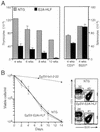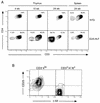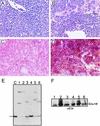Disrupted differentiation and oncogenic transformation of lymphoid progenitors in E2A-HLF transgenic mice
- PMID: 10330184
- PMCID: PMC104403
- DOI: 10.1128/MCB.19.6.4443
Disrupted differentiation and oncogenic transformation of lymphoid progenitors in E2A-HLF transgenic mice
Abstract
The hepatic leukemia factor (HLF) gene codes for a basic region-leucine zipper (bZIP) protein that is disrupted by chromosomal translocations in a subset of pediatric acute lymphoblastic leukemias. HLF undergoes fusions with the E2A gene, resulting in chimeric E2a-Hlf proteins containing the E2a transactivation domains and the Hlf bZIP DNA binding and dimerization motifs. To investigate the in vivo role of this chimeric bZIP protein in oncogenic transformation, its expression was directed to the lymphoid compartments of transgenic mice. Within the thymus, E2a-Hlf induced profound hypoplasia, premature involution, and progressive accumulation of a T-lineage precursor population arrested at an early stage of maturation. In the spleen, mature T cells were present but in reduced numbers, and they lacked expression of the transgene, suggesting further that E2a-Hlf expression was incompatible with T-cell differentiation. In contrast, mature splenic B cells expressed E2a-Hlf but at lower levels and without apparent adverse or beneficial effects on their survival. Approximately 60% of E2A-HLF mice developed lymphoid malignancies with a mean latency of 10 months. Tumors were monoclonal, consistent with a requirement for secondary genetic events, and displayed phenotypes of either mid-thymocytes or, rarely, B-cell progenitors. We conclude that E2a-Hlf disrupts the differentiation of T-lymphoid progenitors in vivo, leading to profound postnatal thymic depletion and rendering B- and T-cell progenitors susceptible to malignant transformation.
Figures








Similar articles
-
Expression of E2A-HLF chimeric protein induced T-cell apoptosis, B-cell maturation arrest, and development of acute lymphoblastic leukemia.Blood. 1999 May 1;93(9):2780-90. Blood. 1999. PMID: 10216071
-
The AD1 and AD2 transactivation domains of E2A are essential for the antiapoptotic activity of the chimeric oncoprotein E2A-HLF.Mol Cell Biol. 1998 Oct;18(10):6035-43. doi: 10.1128/MCB.18.10.6035. Mol Cell Biol. 1998. PMID: 9742120 Free PMC article.
-
Transformation of bone marrow B-cell progenitors by E2a-Hlf requires coexpression of Bcl-2.Mol Cell Biol. 2002 Nov;22(21):7678-87. doi: 10.1128/MCB.22.21.7678-7688.2002. Mol Cell Biol. 2002. PMID: 12370314 Free PMC article.
-
E2A-HLF usurps control of evolutionarily conserved survival pathways.Oncogene. 2001 Sep 10;20(40):5718-25. doi: 10.1038/sj.onc.1204591. Oncogene. 2001. PMID: 11607821 Review.
-
E2A-HLF chimeric transcription factors in pro-B cell acute lymphoblastic leukemia.Curr Top Microbiol Immunol. 1997;220:45-53. doi: 10.1007/978-3-642-60479-9_3. Curr Top Microbiol Immunol. 1997. PMID: 9103674 Review. No abstract available.
Cited by
-
Genetically engineered mouse models of human B-cell precursor leukemias.Cell Cycle. 2014;13(18):2836-46. doi: 10.4161/15384101.2014.949137. Cell Cycle. 2014. PMID: 25486471 Free PMC article. Review.
-
Role for homodimerization in growth deregulation by E2a fusion proteins.Mol Cell Biol. 2000 Aug;20(16):5789-96. doi: 10.1128/MCB.20.16.5789-5796.2000. Mol Cell Biol. 2000. PMID: 10913162 Free PMC article.
-
DNMT3A Arg882 mutation drives chronic myelomonocytic leukemia through disturbing gene expression/DNA methylation in hematopoietic cells.Proc Natl Acad Sci U S A. 2014 Feb 18;111(7):2620-5. doi: 10.1073/pnas.1400150111. Epub 2014 Feb 4. Proc Natl Acad Sci U S A. 2014. PMID: 24497509 Free PMC article.
-
Murine models of acute leukemia: important tools in current pediatric leukemia research.Front Oncol. 2014 May 7;4:95. doi: 10.3389/fonc.2014.00095. eCollection 2014. Front Oncol. 2014. PMID: 24847444 Free PMC article. Review.
-
Conditional Expression of E2A-HLF Induces B-Cell Precursor Death and Myeloproliferative-Like Disease in Knock-In Mice.PLoS One. 2015 Nov 20;10(11):e0143216. doi: 10.1371/journal.pone.0143216. eCollection 2015. PLoS One. 2015. PMID: 26588248 Free PMC article.
References
-
- Ardavin C, Wu L, Li C L, Shortman K. Thymic dendritic cells and T cells develop simultaneously in the thymus from a common precursor population. Nature. 1993;362:761–763. - PubMed
-
- Bain G, Murre C. The role of E-proteins in B- and T-lymphocyte development. Semin Immunol. 1998;10:143–153. - PubMed
-
- Bindl J M, Warnke R A. Advantages of detecting monoclonal antibody binding to tissue sections with biotin and avidin reagents in coplin jars. Am J Pathol. 1986;85:490–493. - PubMed
Publication types
MeSH terms
Substances
Grants and funding
LinkOut - more resources
Full Text Sources
Other Literature Sources
Molecular Biology Databases
